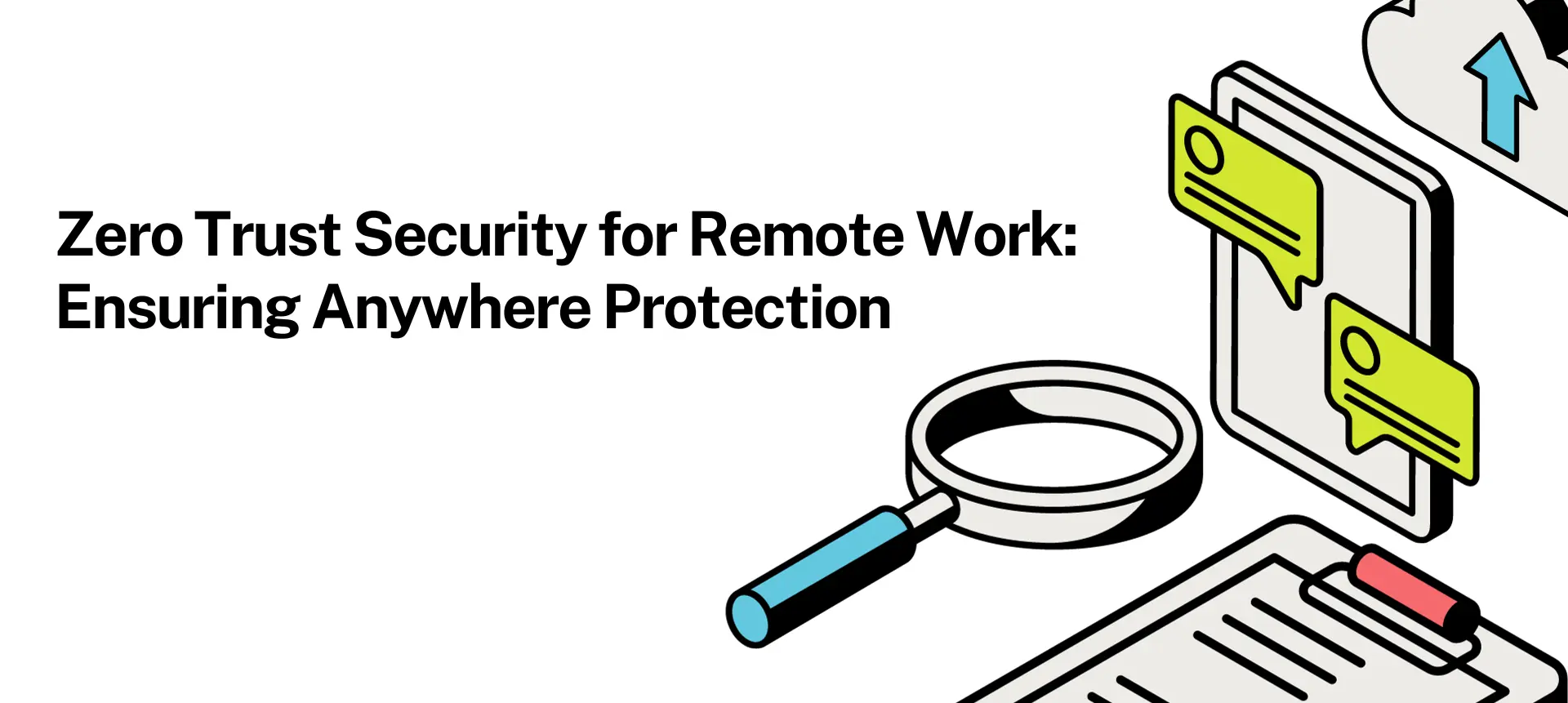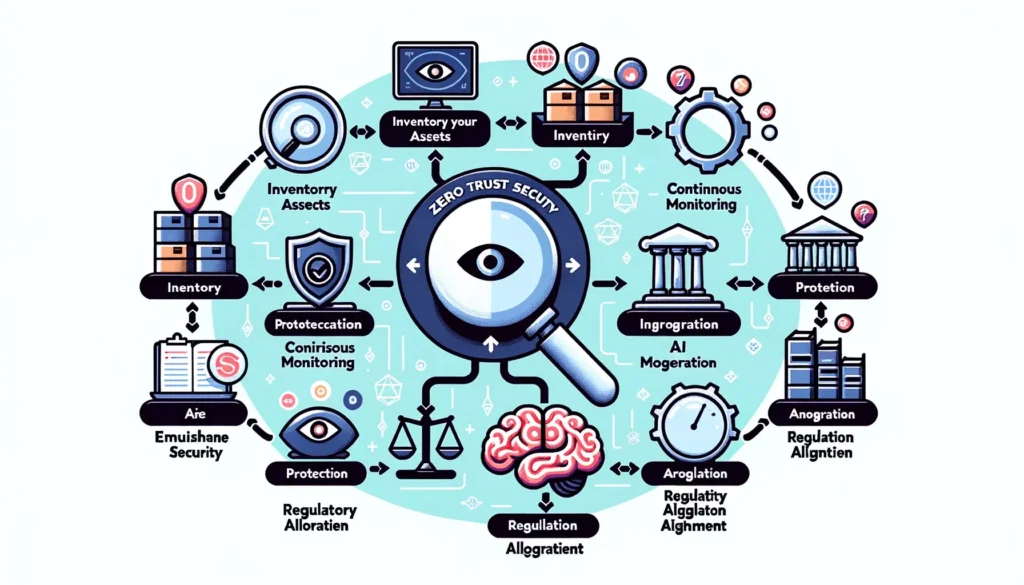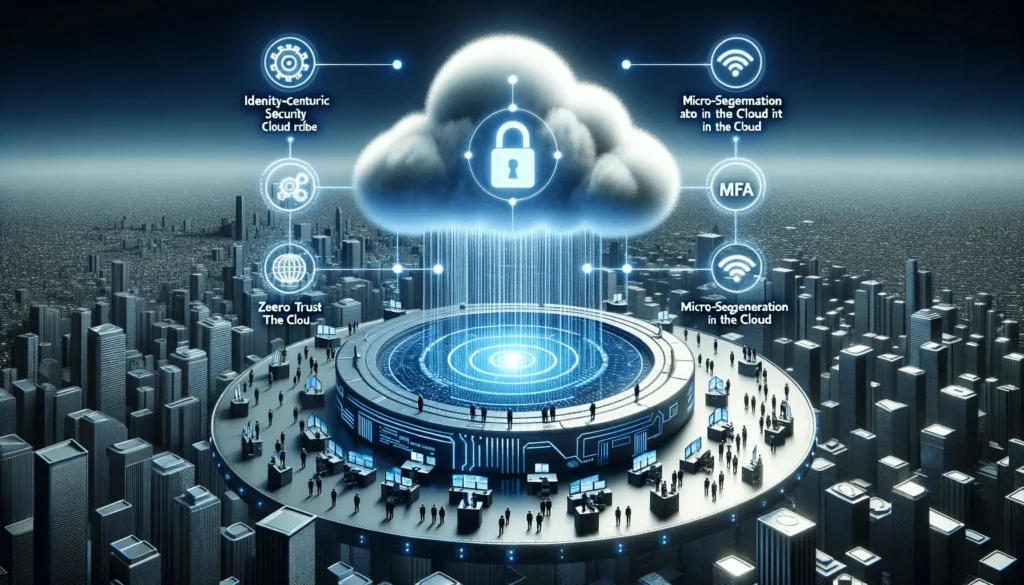
Zero Trust Security for Remote Work: Ensuring Anywhere Protection
- John Quarrie
- October 19, 2023
In an era defined by digital innovation and relentless connectivity, safeguarding sensitive data has become a mission-critical imperative. With cyber threats growing in both scale and sophistication, traditional security models no longer suffice. Enter “Zero Trust Security,” a transformative paradigm that challenges conventional notions of Trust and redefines how we protect our most valuable digital assets. In this digital age, where data breaches make headlines almost daily, the need for a new approach to cybersecurity has never been more apparent. Zero Trust Security stands as a beacon of hope, offering a revolutionary blueprint for fortifying our digital fortresses. It operates on the foundational principle that Trust should never be assumed, regardless of whether the source is internal or external. Every user, device, application, or system must continuously earn Trust, even after gaining initial access.
Demystifying Zero Trust Security: A Comprehensive Guide
1. Understanding Zero Trust Security:
In the traditional realm of cybersecurity, Trust has often been equated with access. Once a user gains access to a network, they are typically trusted to navigate within it. However, this inherent trust assumption has proven to be a vulnerability that cybercriminals exploit with increasing frequency. Enter Zero Trust Security, a paradigm that revolutionizes the way we think about Trust in the digital world.

Zero Trust Principle 1: Never Trust, Always Verify
At its core, Zero Trust operates on a simple yet profound principle: trust nothing and verify everything. Whether it’s a user, device, application, or network segment, Zero Trust advocates for continuous authentication and verification. Even if a user has successfully logged in, their trustworthiness must be continuously assessed based on various factors, such as behaviour, location, and device health.
Zero Trust Principle 2: Least Privilege Access
Another fundamental aspect of Zero Trust is the concept of least privilege access. This means that users are granted only the minimum level of access required to perform their tasks. Unlike traditional models, where users often receive broad access permissions, Zero Trust limits access to what is necessary for the individual’s role, minimizing the potential for unauthorized access or lateral movement by attackers.
Contrasting with Traditional Security Models:
To truly appreciate the innovation that Zero Trust brings to the table, it’s essential to contrast it with traditional security models, such as the perimeter-based approach.
- Traditional Security: The Perimeter Model In the traditional model, security primarily relies on the notion of a network perimeter. Once you’re inside this perimeter—typically protected by firewalls and other security measures—you’re trusted by default. This approach has become increasingly inadequate in the face of modern cyber threats, as attackers often find ways to breach the perimeter.
- Zero Trust: Shattering the Perimeter Zero Trust disrupts the traditional model by eliminating the notion of a trusted inside and an untrusted outside. Instead, it treats every element within the network as potentially untrusted. This approach acknowledges that attackers can be both inside and outside the network. As a result, it puts a strong emphasis on continuous monitoring, verification, and strict access controls, regardless of a user’s location or device.
2. Implementing Zero Trust:
Understanding the principles of Zero Trust Security is just the first step. To effectively protect your digital assets and data, it’s crucial to know how to implement Zero Trust within your organization. This section will guide you through the practical steps and best practices for adopting the Zero Trust model.
a. Inventory Your Assets:
The journey to Zero Trust begins with a comprehensive inventory of your digital assets. Identify all devices, applications, users, and data flows within your network. Understanding what you need to protect is fundamental to implementing Zero Trust effectively.
b. Define Your Security Perimeters:
In the Zero Trust model, security perimeters are not fixed boundaries. Instead, they adapt based on the context and risk factors. Define micro-perimeters around specific assets or data and segment your network accordingly. This segmentation helps contain breaches and limit lateral movement by attackers.
c. Continuous Authentication and Verification:
Implement robust identity verification and authentication mechanisms. Users and devices should continuously prove their trustworthiness, even after initial access. Multi-factor authentication (MFA) and behavioural analytics play a pivotal role in this process.
d. Least Privilege Access:
Follow the principle of least privilege access. Users and devices should only have access to the resources necessary for their roles. Regularly review and update access permissions to ensure they align with business needs.
e. Micro-Segmentation:
Implement micro-segmentation to divide your network into smaller, isolated zones. This limits the lateral movement of attackers within your network. Each segment should have its own access controls and monitoring.
f. Continuous Monitoring:
Continuous monitoring is at the heart of Zero Trust Security. Implement real-time monitoring of network traffic, user behaviour, and security events. Anomalies and suspicious activities should trigger immediate responses.
g. Automation and AI:
Leverage automation and artificial intelligence (AI) to enhance your Zero Trust strategy. AI can help identify threats and anomalies more quickly than manual methods, enabling rapid response to potential breaches.
3. Identity Verification and Access Control:
In the realm of Zero Trust Security, Identity Verification and Access Control are the twin pillars that form a robust defence against cyber threats. Identity Verification entails a shift from static credentials to continuous authentication, requiring users and devices to prove their trustworthiness continually. This involves multi-factor authentication, behavioural analysis, and adaptive access policies that adjust based on real-time risk assessment.
Access Control, on the other hand, adheres to the principle of least privilege, granting users and devices only the minimum level of access necessary for their tasks. Granular access policies, micro-segmentation, and role-based access control ensure that resources are accessible only to those with explicit authorization.
Together, these measures reduce the attack surface, minimize the risk of unauthorized access, and swiftly detect abnormal activities. Identity Verification and Access Control not only safeguard data but also reflect the core philosophy of Zero Trust—Trust is earned through continuous verification, and security is proactive rather than reactive.
4. Zero Trust in Remote Work Environments:
Zero Trust Security is particularly relevant in remote work environments, where traditional security perimeters have dissolved. With employees accessing corporate networks and data from various locations and devices, the need for a more adaptive and robust security approach is evident. In a remote work setting, Zero Trust extends its principles to ensure that Trust is never assumed, regardless of an employee’s physical location. This means that identity verification and access control become even more critical. Employees must continuously prove their identity and adhere to strict access policies, irrespective of whether they are working from the office, home, or a coffee shop. Zero Trust Network Access (ZTNA) solutions play a pivotal role in securing remote work environments. They ensure that only authenticated and authorized users and devices can access corporate resources, whether hosted in data centres or the cloud. By implementing micro-segmentation and real-time access monitoring, Zero Trust mitigates the risks associated with remote work, such as unauthorized access, data breaches, and insider threats.
5. Zero Trust in the Cloud:

a. Embracing Cloud, Embracing Zero Trust:
The adoption of cloud computing has transformed the way organizations manage and store data. While the cloud offers tremendous benefits in terms of scalability and flexibility, it also introduces new security challenges. This is where Zero Trust Security steps in, offering a robust framework to secure cloud environments effectively.
b. The Dynamic Nature of Cloud Security:
Cloud infrastructure is dynamic, with resources scaling up or down in response to demand. Zero Trust’s core principles align perfectly with this dynamic nature. It treats all resources as untrusted, regardless of their location, and continuously verifies access requests.
c. Identity-Centric Security:
In the cloud, identity becomes the new perimeter. Zero Trust emphasizes robust identity verification for users and devices, ensuring that access is granted based on strict authentication protocols. Multi-factor authentication (MFA) and single sign-on (SSO) are integral components of this approach.
d. Micro-Segmentation in the Cloud:
Micro-segmentation, a key concept in Zero Trust, finds a natural fit in the cloud. By dividing cloud environments into smaller segments, each with its access controls, organizations can limit lateral movement in case of a breach and protect sensitive data.
e. Zero Trust Cloud Services:
Many cloud providers offer Zero Trust security services and tools that can be integrated into the infrastructure. These services help automate security policies, monitor access, and respond to threats in real time.
f. Compliance and Data Governance:
Zero Trust is well-suited to address compliance requirements in cloud environments. It ensures that access controls and data protection measures are applied consistently, helping organizations meet regulatory standards.
6. The Future of Zero Trust Security:
As technology continues to evolve at an unprecedented pace, the future of cybersecurity is being shaped by the principles of Zero Trust Security. This dynamic and adaptive approach, once considered a novel concept, is poised to become the cornerstone of digital defence in the years to come.
a. AI and Machine Learning Integration:
The integration of artificial intelligence (AI) and machine learning (ML) is set to revolutionize Zero Trust Security. These technologies will enable more advanced and real-time threat detection, allowing organizations to identify and respond to anomalies with unprecedented speed and accuracy.
b. Zero Trust Beyond Perimeter:
While the concept of a network perimeter fades, Zero Trust extends its reach beyond traditional boundaries. It will encompass not only data centres and cloud environments but also edge computing and the Internet of Things (IoT). Zero Trust will become a holistic security approach for all digital touchpoints.
c. Passwordless Authentication:
Traditional passwords are increasingly vulnerable to breaches. The future of Zero Trust will witness a shift towards passwordless authentication, leveraging biometrics, tokenization, and secure single sign-on (SSO) to enhance identity verification.
d. Continuous Risk Assessment:
Continuous risk assessment will become a standard practice in Zero Trust Security. Organizations will continuously evaluate the trustworthiness of users, devices, and applications based on evolving threat landscapes and contextual factors.
e. Ecosystem Collaboration:
To combat sophisticated threats, organizations will increasingly collaborate within a zero-trust ecosystem. Sharing threat intelligence and security insights will be essential to stay ahead of cyber adversaries.
f. Enhanced User Experience:
Zero Trust Security will not only focus on security but also on providing a seamless user experience. Innovations in user-friendly authentication methods and access policies will ensure that security measures do not hinder productivity.
g. Regulatory Alignment:
As data privacy regulations become more stringent, Zero Trust Security will align closely with compliance requirements. Organizations will adopt Zero Trust to ensure data protection and regulatory adherence.
Conclusion:
In a world where data is the lifeblood of organizations, the need for robust cybersecurity has never been more pressing. “Zero Trust Security: A New Paradigm for Protecting Data” emerges as a beacon of hope in this digital landscape, redefining how we safeguard our most valuable assets. Zero Trust challenges the outdated notion of Trust by introducing continuous verification and strict access controls. It compels us to abandon the assumption that anyone or anything within our network can be implicitly trusted. Instead, it mandates that Trust must be earned and access privileges must be granted sparingly. Throughout this exploration, we’ve delved into the principles, implementation, and prospects of Zero Trust Security. We’ve seen how it adapts seamlessly to remote work environments, secures cloud infrastructures, and embraces cutting-edge technologies like AI and machine learning. As the cybersecurity landscape continues to evolve, Zero Trust stands as a dynamic and adaptive ally, offering a proactive defence strategy against an ever-changing threat landscape. By embracing Zero Trust, organizations can navigate the digital future with confidence, knowing that their data is protected by a paradigm that never rests, never assumes and never compromises on security.
FAQs:
1. What is Zero Trust Security?
Zero Trust Security is a cybersecurity framework that challenges the traditional model of Trust within networks. It assumes that threats can exist both inside and outside the network perimeter and requires continuous verification of user and device identities, strict access controls, and real-time monitoring.
2. Why is Zero Trust Security important?
Zero Trust Security is vital in today’s threat landscape because it provides a proactive and dynamic approach to data protection. It reduces the risk of data breaches by ensuring that Trust is continually verified and access is limited to what is necessary, even in remote or cloud-based environments.
3. How does Zero Trust Security differ from traditional security models?
Traditional security models often rely on perimeter defences and trust once a user is inside the network. Zero Trust, in contrast, treats all elements as untrusted and continuously verifies trustworthiness, regardless of location or device, offering greater security in an evolving digital landscape.
4. What are the fundamental principles of Zero Trust Security?
Zero Trust Security is built on principles such as “Never Trust, Always Verify,” “Least Privilege Access,” continuous authentication, granular access controls, and micro-segmentation.
5. How can organizations implement Zero Trust Security?
Implementing Zero Trust involves steps like identifying assets, defining access policies, adopting continuous authentication methods, embracing micro-segmentation, and implementing real-time monitoring. Partnering with cybersecurity experts can also help in the transition.
6. Does Zero Trust Security hinder user productivity?
While Zero Trust Security focuses on security, it also emphasizes a seamless user experience. Innovations in authentication methods and access policies aim to balance security and productivity, ensuring that security measures do not overly disrupt workflows.
7. How can Zero Trust Security help with compliance and data governance?
Zero Trust Security aligns closely with compliance requirements. By implementing strict access controls and continuous risk assessment, organizations can better adhere to data privacy regulations and demonstrate their commitment to data protection.
8. What is the role of AI and machine learning in Zero Trust Security's future?
AI and machine learning are expected to play a significant role in enhancing threat detection and response in Zero Trust Security. These technologies can identify anomalies and potential threats in real-time, providing a more proactive defence against cyberattacks.
9. Is Zero Trust Security suitable for all types of organizations?
Zero Trust Security can benefit organizations of all sizes and industries, especially those dealing with sensitive data. It offers a scalable approach that can be tailored to fit the specific needs and risk profiles of different organizations.
10. What are some real-world examples of organizations successfully implementing Zero Trust Security?
Several organizations, including Google, Microsoft, and government agencies, have adopted Zero Trust Security models. Case studies and success stories highlight how these organizations have enhanced their cybersecurity posture and protected their data effectively.
Reference sites:
Here are some reference websites related to the topic of “Zero Trust Security” where you can find more information, resources, and in-depth articles on this subject:
- NIST – Zero Trust Architecture: The National Institute of Standards and Technology (NIST) provides comprehensive guidelines and resources on implementing Zero Trust Security. NIST Zero Trust Architecture
- Forrester Research – Zero Trust: Forrester offers research reports, webinars, and blog posts on Zero Trust Security strategies and trends. Forrester Zero Trust
- Cybersecurity and Infrastructure Security Agency (CISA): CISA’s website includes resources and best practices for implementing Zero Trust Security in federal agencies and beyond. CISA – Zero Trust
- Cloud Security Alliance (CSA): CSA provides whitepapers, research, and guidance on implementing Zero Trust in cloud environments. CSA – Zero Trust
- Microsoft Zero Trust Security Center: Microsoft offers insights, case studies, and practical guidance for implementing Zero Trust Security using their technologies. Microsoft Zero Trust Security
- Google Cloud – BeyondCorp: Google’s BeyondCorp framework is a practical implementation of Zero Trust, and its website provides valuable insights and resources. Google Cloud BeyondCorp
- Cisco Zero Trust Security: Cisco’s Zero Trust Security webpage offers information on its solutions and best practices for implementing Zero Trust. Cisco Zero Trust
- Palo Alto Networks – Zero Trust Security: Palo Alto Networks provides resources and information on Zero Trust Security, including articles and case studies. Palo Alto Networks Zero Trust

